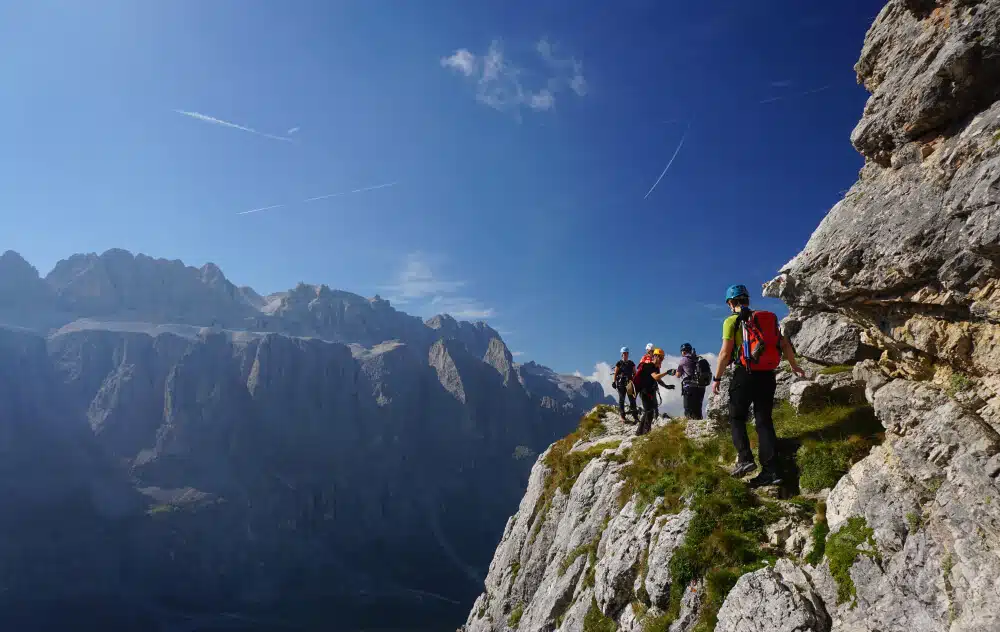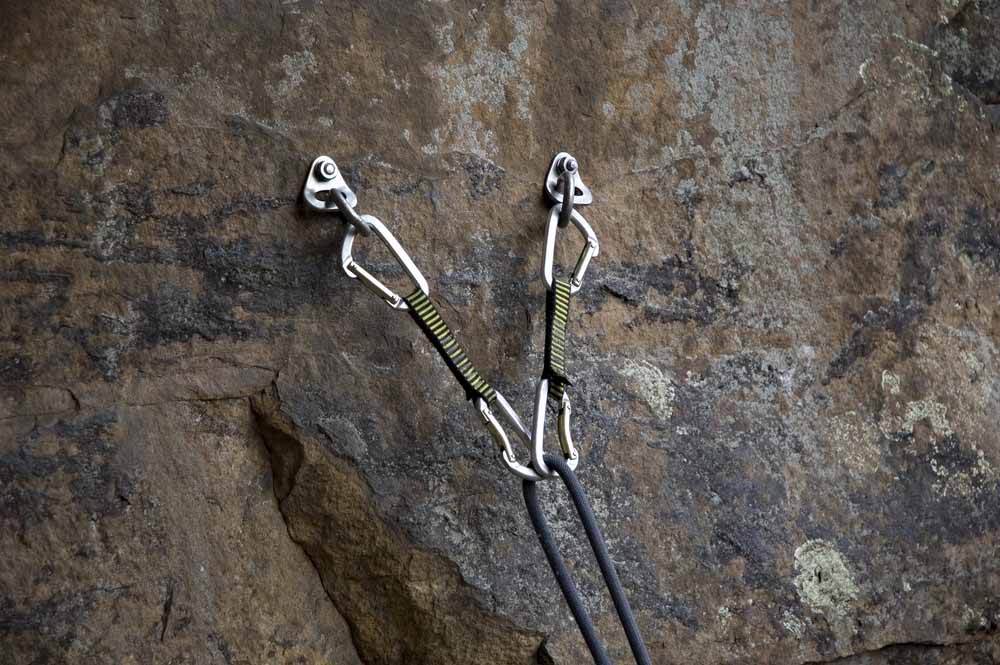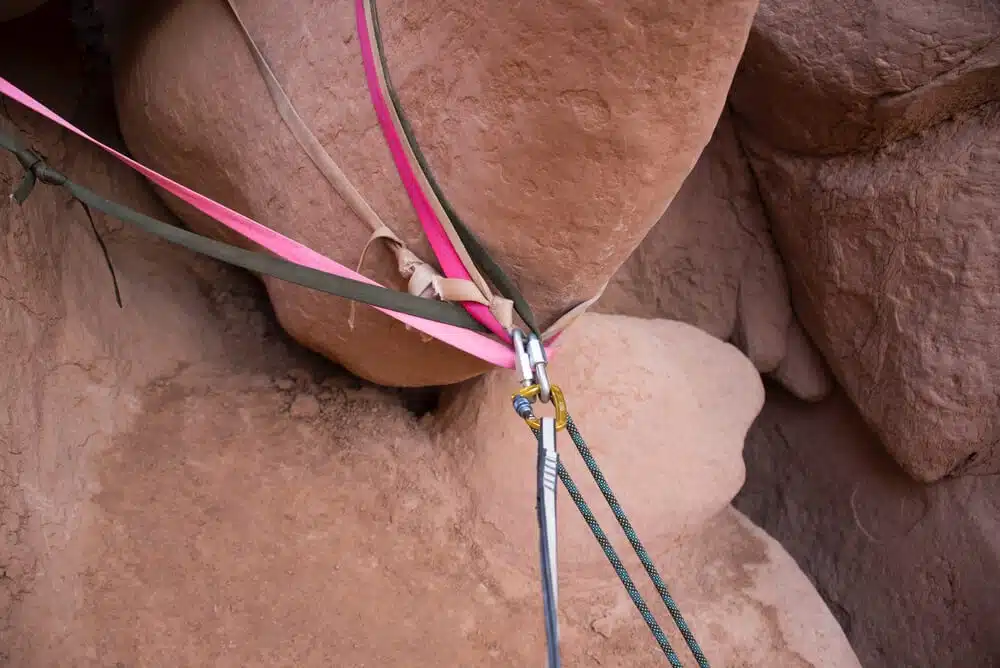In the guiding world, we talk a lot about a concept called “edge safety.” For first-timers, it may not be that hard to deduce what edge safety means based on its name. Edge safety is all about being safe around the edge of a climbing cliff.
However, despite the relatively straightforward definition of edge safety, an alarming number of climbers are not making simple edge safety considerations to keep themselves safer when operating around the edge in a rock climbing context, especially when building anchors.
So, in this article, I want to extrapolate on:
- What I consider “edge safety” to mean
- The different ways I think about edge safety
- Considerations for real-world climbing scenarios
The goal of this article is to help readers develop a more in-depth understanding of edge safety, which can help them climb with less risk and perhaps even avoid a catastrophic disaster.
The Climber’s Relationship to the Edge
Human beings are evolutionarily and instinctually cautious around precipices. That’s because we know falling off the precipice and into the void will inevitably cause us severe harm or kill us. However, as rock climbers, we tend to throw our pre-programmed tendencies out the window to avoid cliff edges. Instead, we walk towards the cliff, look over the edge, hang off the side of the cliff, and sometimes even fall off the cliff (with a rope attached, of course).
As a result, we get comfortable operating around cliff edges and become desensitized to the consequences that could arise if we fall off. For climbing guides or recreational climbers with a propensity for caution, this is not such a big deal because guides and cautious climbers tend to prioritize edge safety despite their relative comfort while being in the proximity of a precipice. However, for brazen climbers who lack the skills to operate around the edge carefully, comfort is often disguised as complacency, which could spell disaster.
Fortunately, that’s where an understanding of edge safety can come into play to inform how you operate around the edge and what to look out for regarding risks.
What is Edge Safety?
As I mentioned in the intro, edge safety is pretty much exactly what it sounds like—taking precautions to be safe around the edge of a climbing cliff. However, there are some nuances to edge safety that I’m not sure every climber considers when rappelling, building anchors, or even just hiking around the edges of cliffs. But before I get to those, let’s provide an ideal definition of edge safety besides just the generic “be safe around edges.”
Edge safety is a mindset that climbers can adopt that continually informs their decision-making when in the proximity of an edge. This mindset is informed by a series of cautious risk management practices that help mitigate the risk of a severe or catastrophic accident from falling off a cliff.
Being safe around cliff edges starts well before approaching the edge
Edge safety begins with being equipped with the correct tools to provide oneself with safety when getting near an edge. In rock climbing, this means being prepared with all the necessary equipment before exposing yourself to an edge.
- A helmet to protect your head in the event of a fall
- A climbing harness to attach your body to your anchoring system
- Locking carabiners for critical linkages in an anchoring system
- Anchor building material (i.e., static rope, cordelette, sewn slings) for, you guessed it, constructing bomber anchors
- Tethering tools (i.e., personal anchor systems) to attach yourself to the anchor
If you are walking toward an edge in a climbing scenario and you are not equipped with these tools, turn around.
Edge safety is an ongoing and never-ending practice
I don’t think it’s possible to be “done” being safe around an edge. Or to “accomplish” edge safety. Instead, I think that edge safety is an ongoing series of decisions and an overall mindset that you deploy every single time you go climbing and throughout the entirety of being in the danger zone.
If you approach the idea of being safe around cliff edges with the understanding that edge safety is ongoing, you will be more mindful of your decisions and have more heightened risk management while exposed to edges. On the other hand, without this mindset, one can fall victim to complacency, resulting in a close call, suffering an accident, or perhaps falling and not surviving.
Edge Safety While Building Top Rope Anchors
Okay—enough with the conceptual theoretics. Let’s get into the real-world stuff. One of the areas where I see rock climbers consistently fail to provide themselves with edge safety is when they build top rope anchors. This is ironic because, throughout the process of constructing a system you plan to trust with your life, you’re exposed to potentially catastrophic consequences.
Let’s stop doing that. To remain safe around the edge while building top rope (TR) anchors, it can be helpful to think about things systematically.
Have a plan
The edge of a cliff is not the place to brainstorm your grand plan for where you want to drop your TR. Instead, you need to have a plan fleshed out before getting to the edge. Your plan should include a general understanding of:
- Where your route is located
- The length of rope you need
- The type of anchor you want to construct
- Available anchor points (i.e., cracks, trees, boulders)
- The required gear (i.e., cams, nuts, etc.)
The more detailed your plan is, the better.
Create an anchor before building your anchor
If you don’t know exactly where your route is or where your TR needs to hang, and you want to approach the edge to get a better idea of your surroundings, then you should add a level of security.
The best way to do this is to build a temporary bomber anchor somewhere away from the cliff’s edge that you can attach yourself to. This will provide you with edge safety while you gather more information and eventually build your TR anchor for climbing.
My preferred tactic for this is to build a bomber anchor, maybe it’s three good cams or a couple of trees, and fix a static rope to the anchor to create a long tether or lifeline. From there, I connect myself to my static rope with my Grigri. (I like the Grigri because it’s “adjustable,” but you can also attach yourself with a clove hitch or just a knot and locking carabiner). With a tether, I can approach the edge, knowing I’m attached to something that will catch me if I fall.
Clip the bolts
Some crags have bolts at the top of the cliff for building anchors. For example, that’s the case for the Peterskill, a super popular top-roping area in the Gunks where I guide, and North Table Mountain in Golden, Colorado. Sometimes, the bolts are located on the top of the cliff and require an anchor to be extended from the bolts and over the edge. Other times, the bolts are on the cliff face itself.
Regardless of where the bolts are located, the first thing you should do is clip yourself to at least one bolt with your tethering tool. (Clipping more than one is preferred.) Whether you clip one or two bolts is up to you. However, whatever you do, please do not carry out your entire anchor construction process near the edge of the cliff without being attached.
Other Edge Safety Considerations
- Mitigate overhead hazards: Being around the edge is a risk not only to yourself but also to the people below you because you can introduce overhead hazards (e.g., dropping equipment and kicking off rocks).
- Always avoid sharp edges: Edge safety isn’t just about protecting yourself around edges. It also includes protecting your climbing rope from sharp edges. Never let your climbing rope repeatedly abrade itself over a sharp edge. This can cut the rope and cause an accident
- Follow the body length rule: A good rule of thumb to remember is the body length rule. If you are within a body length of the cliff edge and you slip, trip, or fall, you may go over the edge. Therefore, if you are within a body length, you need to add security by tethering yourself to an anchor system
- Pay attention to unstable surfaces: Not all edges are created equally. Some consist of crumbly soil or soft rock, while others are made of bullet-hard stone. If you are working around a questionable edge or cannot identify where it starts or ends because of plants, you need to add security by tethering yourself to an anchor before approaching the cliff.
Final Thoughts: the edge is not your friend
No matter how desensitized to heights you are or how chill you are while in the proximity of a cliff, remember, the edge is not your friend. Instead of being lured into a state of complacency around the edge while you are rock climbing, hold yourself accountable to an ongoing commitment to edge safety.
Have a plan before approaching the edge, invest in the appropriate tools, and when in doubt, attach yourself to an unquestionably strong anchor system. The extra time it takes to level up your security while in the proximity of an edge is always worth it.













